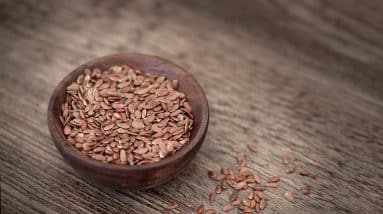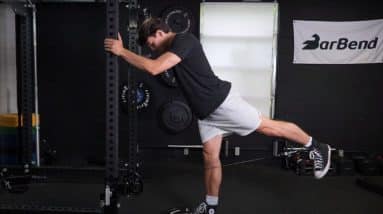
Master the Art of Glute Kickbacks for a Bootylicious Behind
If you’ve been on board the bigger butt train, certain lower body exercises stand out. Squats, deadlifts, lunges, and hip thrusts have the center stage. But when you’re likely too tired for another set of squats, the glute kickback is ready to target your backside — without the added strain of another heavy barbell.

Here’s how this glute accessory exercise can up your gains.
How to Do the Glute Kickback
The glute kickback is a cable-based exercise that allows you to specifically target your glutes. It is performed using a few different implements or specialty pieces of equipment, but the simple cable machine serves as the standard. Here’s how to perform the glute kickback.

- Step 1 — Place the ankle strap on the cable machine carabiner and adjust its height to the lowest position
- Step 2 — With the ankle strap around your ankle, face the cable machine and lightly hinge to stabilize. Place most of your weight on the non-working leg. This is your starting position.
- Step 3 — Using your hands and free leg to brace, press into the machine to create a counterforce to your kickback. Brace your core, tighten your legs, and secure your grip on the cable machine as stability points.
- Step 4 — Keep your working leg long, with only a subtle bend at the knee. Squeeze your glute on the working side as you drive your leg backward against the resistance.
- Step 5 – Once your glute has fully contracted, slowly lower back to the starting position. Perform for repetitions.
Coach’s Tip: Start your sets with your non-dominant side, which is often your weaker side. This way, you’re setting a movement standard that you can accomplish evenly.
Glute Kickback Variations
The glute kickback is a great way to isolate your glutes as much as possible and pepper in much-needed training volume without taxing your lower back under a barbell.
If you’re searching for some variations on the glute kickback, a few great choices are the donkey kick, a machine glute kickback, or a 45-degree cable kickback.
Donkey Kick
[Read More: 10 Glute Exercises You Can Do at Home]
Why Do It: This bodyweight glute exercise is a way to isolate your glutes without weight. You’ll get the added bonus of a balance challenge and solid mind-muscle connection.
Equipment Needed: You don’t need anything except yourself and possibly a yoga mat here.
- Begin in the quadruped position (on the floor on your hands and knees).
- Brace your core and tighten your back to stabilize your position.
- Squeeze your right glute, raising your right leg into the air. Lower it back down to the starting position and repeat with the left leg for repetitions.
Glute Kickback Machine
[Read More: Better Glutes, Better Pulls: How Should We Approach Glute Training For Powerlifting]
Why Do It: Here, you’ll have a machine to brace your body against. Take advantage and up the weight with this isolation exercise so that you can focus as much as possible on the activation of your gluteal muscles.
Equipment Needed:
- Line up in the machine with your working foot flat against the footpad and your hands or shoulders braced against the pads provided.
- Squeeze your hands and engage full body tension to provide stability.
- Drive your working leg backward by pressing through the full foot. Extend the leg until you feel a complete glute contraction.
- Slowly lower back to the starting position and repeat for repetitions.
45-Degree Cable Kickback
[Read More: The 15 Best Cable Exercises for Hypertrophy, Strength, and Stability]
Why Do It: These cable glute kickbacks keep your leg at 45 degrees. Keeping your leg this way will bring your hamstrings and calves more into the movement, and it also targets your gluteus medius a little more than the usual variation.
Equipment Needed: This move just needs a cable machine and ankle strap.
- Set up your cable machine the same way you would a standard glute kickback.
- Brace against the machine and stabilize your body. Drive your working leg backward at an approximate 45-degree angle.
- Fully contract the working glute to complete each repetition. Slowly lower back to the starting position and repeat for repetitions.
Glute Kickback Alternatives
If your cable machine is out of commission or you’re simply looking for some alternatives to play with, we’ve got some great alternatives for you. The best exercises here will give your glutes fantastic stimulation while allowing different angles than your major lower body exercises.
Resistance Band Abduction
[Read More: Best Resistance Bands for Glutes of 2024]
Why Do It: Many athletes do moves like this one to warm up for squats, and with good reason. Train yourself to resist unintended, overexaggerated collapsing of your knees inward during loaded squats and other knee-and-hip focused moves.
Equipment Needed: You’ll need a plyo box or a weight bench, along with a mini resistance band.
- Take a seat on the edge of a bench or a box. Wrap a resistance band around your knees.
- Slightly hinge forward and brace in this position. Engage your core and pre-tighten your legs.
- Drive your knees out against the band resistance. Keep squeezing until your glutes feel fully contracted. Return to the starting position under control and repeat for repetitions.
Machine Hip Abduction
[Read More: Are You Leaving Glute Gains On the Table? Try This Two-Move Finisher]
Why Do It: Since you’ll be seated and braced against the machine, you can afford to up the weight once you’re sufficiently warmed up. You can load heavily without strain on your lower back or overall body.
Equipment Needed: You’ll have to find a hip abduction machine for this one. Otherwise, opt for the banded version, described above.
- Sit down in the machine with your outer legs snug against the pads and your back flat against the backrest.
- Start with the machine in the position that allows your legs to begin as close together as possible.
- Brace your full body and maintain this starting posture. Drive your legs out against the pads until your glutes have fully contracted. Repeat for repetitions.
Step-Up 
Why Do It: You can customize this move to your mobility and fitness level by using a different size step (or plyo box). That way, beginners can take this move to the next level while advanced athletes can also use it to improve mobility and unilateral strength while jacking up the heart rate.
Equipment Needed: Use a step-up platform or plyo box for this one. Dumbbells in your hands are optional.
- Select a box that allows you to get approximately 90 degrees or more of knee flexion.
- Place one foot on the box, brace your core, and tighten your legs.
- Place as much weight as possible on the working leg and step onto the box.
- Lower yourself under control back to the starting position. Avoid letting gravity do the work as much as possible. Repeat for even repetitions per leg.
Who Should Do the Glute Kickback
The glute kickback is often overlooked as a prominent glute exercise, though it shouldn’t be. It has clear benefits for physique enthusiasts but also is extremely helpful for gym newbies and older lifters alike.
- Physique Enthusiasts: If you want to compete in bodybuilding or simply have some jeans you want to fill out, glutes are a must. Outside of big barbell or machine exercises (such as squats or leg presses), the glute kickback has been a fixture for physique enthusiasts for ages. The precision targeting and ability to train with greater frequency cannot be beaten.
- Beginners: There are a lot of transferable benefits that a newcomer to the gym gains from the glute kickback. The central focus is always gaining muscle mass, but the set-up and execution of a good cable-based glute kickback teach a ton about proprioception and discipline. This reinforces proper technique and allows you to chase high-intensity sets through the burn instead of heavy weights.
- Older Lifters: A strong set of hips is a huge asset as you age, and the glute kickback is a lifter-friendly way to keep targeting your glutes. Many of the staple lower body exercises that hit your glutes are also very physically demanding in other ways. The glute kickback provides a low barrier to entry method of stimulating the hips, building proprioception, and confidence for an older or less experienced lifter.
Glute Kickback Sets and Reps
The glute kickback isn’t one that you’re going to do for max load. Since you are using a long lever with your leg, heavier loading would break down your form too quickly. Instead, try using sets and reps for muscle, endurance, or even warming up.,
- For Muscle Mass: Perform 2-4 sets of 10-15 repetitions. Aim for 1-2 repetitions in the tank at the end of each set and rest for 90 seconds to 2 minutes between sets.
- For Endurance: To build endurance, perform 3-4 sets of 15-20 repetitions per leg. Plan for only 30 seconds of rest between sets and aim to feel a vicious burn.
- For Warming Up: To warm up for other lower body exercises, perform 1-2 sets of 15-20 repetitions per leg. Use a 1-2 second pause in the fully contracted position for the best results.
Benefits of the Glute Kickback
The glute kickback builds your glutes, especially when you combine it with a full lower-body workout. It stands out because it also allows for some precision targeting of specific sections of your glutes and deals with significantly less load than the barbell exercises in your program.
Bigger Glutes
Most of the tools in your glute workout box are going to be compound exercises. This means that they may also target your quads and hamstrings, and certainly engage your core. The glute kickback helps to work around these other muscles, making it easier to isolate your glutes as the main target.
Precision Targeting
With more specific isolation comes a better chance at growth. Here, you’ll be more successful in making the glutes your primary muscle without other areas getting in the way and building fatigue.
The glute kickback doesn’t just make it easier to isolate your whole glute — you’re also able to angle the exercise to help load certain regions of your butt. The gluteus maximus, medius, and minimus make up the three major glute muscles and all contribute to your glute kickback.
Choosing specific angles to perform your kickback helps to align with the muscle fibers of your gluteus medius. Your gluteus maximus is the workhorse of force production, but choosing a 45-degree angle for execution helps stress your gluteus medius a bit more too.
Lighter Load
One of the biggest benefits of cable-based exercises is the lighter loads needed to gain stimulus compared to free weights. The glute kickback is no exception. Compared to a squat or a deadlift, the glute kickback needs next to no weight to make it a challenge.
Since you keep your leg long and use precise control to perform your glute kickback, even lighter loads feel heavy. You’ll still get great growth but it also allows you to use way less weight to accomplish the goal.
Muscles Worked by the Glute Kickback
The glutes are the major muscle group worked by the glute kickback. The glutes are broken down into their three distinct muscles; being, the gluteus maximus, the gluteus medius, and the gluteus minimus.
|
Gluteus Maximus |
Gluteus Medius |
Gluteus Minimus |
|
|
|
[Read More: Try These Kettlebell Glute Workouts to Kick Your Butt Into High Gear]
Common Glute Kickback Mistakes
Although the glute kickback is a relatively straightforward exercise, there are still some common mistakes that flare up from time to time. Not bracing properly, adding too much momentum, and improper load selection are the biggest culprits.
Not Bracing Properly
The point of the glute kickback is to target and stimulate the glutes as specifically as possible. This means squeezing your butt, and subsequently, your butt moving the weight. While that may sound silly, the reality is that a lot of lifters move other parts of their body to accomplish the glute kickback.
Anchoring yourself in place with a strong brace and counterforce against the machine (using your arms to lock yourself in a specific position) are key ways to isolate your glutes. Do not allow your lower back to arch, don’t flare your upper back, or sway your hips. Brace up, and only contract your glutes. Movement from your butt should move that pulley, nothing else.
Momentum
Momentum is an issue with nearly every exercise from time to time. And sometimes, a bit of body English toward the end of your set can help you push past failure and add some extra growth potential.
 Credit: Nikolas_jkd / Shutterstock
Credit: Nikolas_jkd / Shutterstock
The issue arises when you accidentally use momentum that you didn’t mean to do, kicking in other areas of lower body strength to get you to the top of the movement without enough challenge to your glutes. Be disciplined, brace up, and only contract your glutes with proper form and a full range of motion.
Too Much Weight
The glute kickback takes advantage of a longer level system than say a leg press. This means that your leg staying relatively locked out keeps the resistance further from the muscle that is moving it. This makes the weight feel heavier and thus you need less of it to perform the glute kickback.
[Read More: Are Squats the Most Effective Exercise for the Glutes?]
This also means the glute kickback is susceptible to form breakdown if you load it too much. This same longer lever amplifies the challenge against your brace, meaning shooting for strength is likely to break you down even faster. Aim for loading schemes that allow you to mainly feel the glute, maintain position, and hit close to muscle failure around 10 to 15 repetitions.
Kicking Into High Gear
The glute kickback has been lurking around gyms since the introduction of cable machines. While some lifters hesitate to add them in, glute kickbacks pair just as well with squats and deadlifts as the dumbbell flye does with the bench press. For added glute gains with less load, a great proprioception builder, and a way to chisel in specific areas of your backside, look no further than the glute kickback.
FAQs
The glute kickback is a great way to add some spice to your lower body routine. Here are answers to any lingering questions.
Glute kickbacks are fantastic for the glutes. Think of them as the dumbbell flye to your bench press or straight-arm pulldown to your dumbbell row. They give you another huge shot of stimulation for glute growth from a different angle and use less weight to accomplish the job. They serve as a fantastic synergist to your squat or hip hinge moves.
The question of “better” depends on what you want. If you want a glute isolation exercise, then you want the kickback. Searching for a way to build stronger glutes without taxing your lower back or other parts of your lower body? The glute kickback wins that, too.
But if you want an overall strength and mass builder that heavily involves the glutes, the squat takes the cake.
For a well-balanced program, aim to integrate both of them into your workouts. The better philosophy is to integrate them both into your workouts. Generally, you’ll start your day with squats and use the kickback as an accessory move.
The glute kickback primarily works your gluteus maximus, medius, and minimus. While this move is by no means a core exercise, you’ll also need to brace through your core.
The post How to Do Glute Kickbacks to Build Your Butt appeared first on BarBend.

Iliza Shlesinger’s Empowering Prenatal Pilates Routine: A Fitness Journey for the Health and Fitness Enthusiast
A Pilates session with comedian Iliza Shlesinger isn’t a quiet event. Class might involve her dog, Tian Fu, jumping on the reformer, or her 2-year-old, Sierra, pulling at the ropes. It will definitely feature Shlesinger’s snide commentary (“I call this move ‘the Sasquatch’”). And these days, it might also include a few pregnancy-induced burps.
Shlesinger first started doing Pilates shortly after Sierra was born, and she quickly got hooked. She invested in her own reformer to regularly train at home with Pilates trainer Alisha Mullally, and began doing mat workouts on her own whenever she was on the road for work. Today, snippets of Shlesinger’s Pilates sessions make almost as many appearances on her Instagram account as snippets of her stand-up.
When she became pregnant again in 2023, Shlesinger says there was no question that she would continue practicing prenatal Pilates, but with a few modifications, in order to stay safe. “I believe a big part of a healthy pregnancy is carrying on with all the things you did before you were pregnant,” she says. She also knows that safely exercising during pregnancy offers a whole bunch of benefits: The American College of Obstetricians and Gynecologists says doing so can help reduce back pain and constipation, and may decrease your risk of gestational diabetes and preeclampsia. One 2018 study even found that those who regularly work out while pregnant spent almost an hour less in labor.
A couple months before her due date, Well+Good filmed an episode of our online video series “Good Moves” with Shlesinger and Mullally at Avenir Pilates in Burbank, California. In it, they demonstrate a feel-good prenatal Pilates routine on the reformer that’s safe for any trimester.
Want to see the whole Good Moves routine? Check out the video below, or follow this link.
Following the “Good Moves” video, we chatted with Shlesinger to learn more about her approach to Pilates, why it’s become an essential part of her prenatal routine, and what she has to say to her skeptics on Instagram.
Question: What made you start doing Pilates after having your first baby?
Iliza Shlesinger: My manager told me that she’d been doing Pilates with this incredible trainer who came to her house. And, you know, once you have a baby, it’s weird: All you want to do is leave the house, but the last thing you want to do is leave the house. So I was introduced to my trainer, Alisha, and we started doing mat Pilates.
Q: What did you like about Pilates?
IS: It was very difficult but also gentle at the same time. And I got to lay down, which was such a plus.
Q: What have been the main modifications you’ve made while pregnant?
IS: There’s no more laying down on my back, and there are no abs to engage. But my trainer’s like, “Doesn’t mean we can’t work your arms!” And you can always work your inner thighs, which feels a little weird because of all the relaxin. Really, my favorite part is beating myself up about how bad my workout is and then having my trainer tell me like, “No, you did great. You’re very pregnant.” And then I’m reminded like, yeah, I’m growing a human. It’s okay that we didn’t do legs and loops today.
I just toured through Europe [and while I was there, tried to practice Pilates]. There was this one guy in France who just looked at me, and in a very French way was like, No, I don’t train pregnant women. I respected that [but] I’ve been doing Pilates long enough that I know how to make my modifications, [so] I signed like a little waiver. And then the bulk of the exercises we did, I just couldn’t do it, but I had too much pride to leave. So I just sat there doing very tiny ankle flexion workouts.
Q: Do you have any favorite prenatal Pilates moves these days?
IS: Anything I can do where I can feel my upper thighs screaming makes me feel like I have some control over what’s going on. And “hug a tree” is always nice because you get to see yourself in the mirror, and I don’t look pregnant in my arms, so that’s always a nice little walk down memory lane.
Anything I can do where I can feel my upper thighs screaming makes me feel like I have some control over what’s going on. —Iliza Shlesinger, on her favorite prenatal Pilates move
I also do a lot of balancing moves. You can see them on my Instagram, and I always get annoyed when people comment that I shouldn’t do it: I’ve been doing Pilates for over a year with a trainer. Plus, she’s [with me when I’m practicing].
Q: Everyone’s an expert on Instagram.
IS: Everyone’s an expert on women on Instagram, for sure. What would we do without the comments section?
Here’s a rule: Don’t tell pregnant women what they can and can’t do. There are women flipping cars and tires in CrossFit who are pregnant just like me. I’m fine.
Q: Do you feel different at all after a Pilates session?
IS: I always love feeling sore the next day. As an “athlete”—please put that in quotes—you always feel like it’s a job well done. You got to a muscle that maybe you had neglected or needed a little extra attention. You never feel bad having done a workout, no matter how short it is. Even if you only get a little bit of sweat, a little bit of your heart rate up, it’s still something.
Q: And how does it affect you mentally?
IS: Any time you can carve out time for yourself, not looking at your phone, it’s always good to come back into the world with fresh eyes, feeling a little exhilarated, having exhausted yourself. The actual only way to get me to not be on my phone is to pay someone to train me. I’m always cognizant of the fact that I paid for the hour, so I try to get every last drop out of it. But we have a lot of fun. We let the dog come in. Sometimes my daughter comes in, and that’s bonus weight on the carriage.
Q: I was going to ask, is that intentional to have your daughter watch you stay active throughout your pregnancy?
IS: Ever since she was little, she would sit in her little baby bouncer and she’d watch. It’s cute—she says the word “Pilates” and she knows that there’s ropes involved and she just wants to be with us. Any behavior you model for your child, they internalize. My mother worked out. She also had a job and she was a single mom for a while who took care of all the gardening and all the maintenance and never talked about it. She just did it. And I think there’s an incredible benefit to women seeing other women naturally just do very strong things because it instills it in you without being demonstrative about it.
Q: Any last thoughts on Pilates you want to share?
IS: I own an Allegra 2 reformer, and I love it. But I also think mat Pilates offers so many benefits. You can do it anywhere. You don’t even need a sports bra. You don’t even need pants on. You can do it in a hotel room on a towel. And trust me, I have.
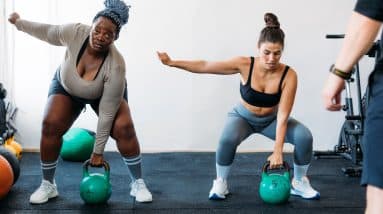
Stop Comparing Your Body to Others at the Gym: Here’s How to Preserve Your Joy and Confidence
You’ve been wanting to try the cardio dance class everyone’s been talking about. You sign up and pick out your cutest gym outfit—ready to slay your workout. But you walk in and you immediately regret it.
The room is full of women seemingly fitter than you. Never have you felt more aware of the size of your body. This was supposed to be a fun and health-giving experience, but it’s become a serious self-loathing session.
If you’ve ever experienced body comparison at the gym, you know it can dissolve your happiness in a blink. But the gym is a place for folks of ALL sizes. So how do you take advantage of the fitness classes and equipment there—without feeling discouraged about your body image?
Studies show that comparing your physique to others lowers your positive body image and increases your odds of developing an eating disorder. Below nutrition and fitness experts, who assist people in their body-acceptance journeys, are offering advice on how to not size yourself up to others when you work out.
5 tips to stop engaging in body comparison at the gym 1. Prepare your mind in advance
When it comes to addressing body image issues around exercise, the work starts before you enter the gym doors, says Rebecca Toutant, RD, CEDS, CDCES, CPT of Nourishing Bits and Bites. Consider your self-talk while working out. Is it negative or positive? Do you already struggle with body acceptance?
Often repetitive negative thoughts about our body aren’t true. Toutant reminds us, “What we ‘see’ in the mirror and in looking at others is not objective truth or fact. Rather, how our brain processes the information is influenced by our emotional state.”
How can you get amped up with positive thoughts before a workout? Start with gratitude for your own body. Affirmations and personal mantras can be repeated to flip negative thinking to positive. Eating disorder specialist Laurie Dunham, RD, CED-S, LD, suggests the following examples:
- “I am thankful for my strong legs that carry me through the day.”
- “I am thankful that my arms allow me to hug the people I love.”
- “I am grateful for a functioning GI system that allows me to properly digest food so I have the energy needed to work and play.”
- “I am enough.”
- “I am strong.”
- “I am more than a body.”
What else can boost your confidence before you walk into the gym? The right playlist! Toutant suggests, “Choose empowering audio. Put on some tunes that leave you feeling strong and confident.”
If that doesn’t feel like enough to help you work through any blocks or limiting beliefs you have about your body, consider seeking out help from a therapist to get to the root causes and address them.
2. Appreciate body differences
The gym presents a display of various body types. The key is to not compare and despair when you see people who look different than you. “There will always be aspects of others we are envious of, but if we can turn that energy into trying to appreciate differences, it can be incredibly beneficial,” Dunham says. “It would be so boring if we all looked the same!”
Studies show that body appreciation is related to better eating habits, fewer body image disturbances, and overall improved mental health. Add to that list enhanced sexual satisfaction and self-compassion and I’d say it’s time to extend a thank you to your body.
Furthermore, your body size does not determine your physical fitness or overall health. “Someone can ‘look’ what society may describe as ‘healthy’ or ‘fit’, but they may be struggling with health or performance,” Toutant points out. Conversely, health is possible at every size—despite what weight stigma would have us believe.
3. Focus on your own fitness
Ever hop on the treadmill next to someone and enter an unspoken competition? Or add on more weight than what’s comfortable to the barbell because someone else can lift that much? Using someone else’s performance as a measuring stick for your abilities is a surefire way to increase your chances of injury and overtraining.
“Your needs and progress are your own,” Toutant says. “Whether or not someone can do more or go faster doesn’t ‘undo’ how far you’ve come. You ARE worthy of belonging right here, right now, as you are. There’s nothing to prove.”
When you feel your gaze wondering to those around you to see how you stack up to what someone else is doing, take it as a sign to recenter yourself and remember why you’re working out in the first place. “Focus on intrinsic goals,” Dunham says. “Think about where you are now and where you want to be concerning strength, flexibility, endurance, and how you feel, both mentally and physically, every day.”
4. Be friendly
Your insecurity may make you feel closed off from others, but gym friends can make all the difference! Resist the urge to withdraw. “Smile. Laugh. Consider eye contact. So many people walk around plugged in, blank stare, and in their own world—often to preserve themselves,” Toutant says. “You don’t need to make best friends, but it’s okay to acknowledge one another.”
While you may think everyone is noticing your imperfections, other gym-goers are not concerned about your body. Instead, everyone is in the same boat. They may even be feeling apprehensive about a new class or gym like you are, which is totally normal.
“Many people feel insecure at the gym,” Toutant says. “There is so much vulnerability in trying something new, re-starting a journey after a pause, moving your body in new ways, your body not feeling the way it used to, seeing unfamiliar faces, and quite literally feeling physically and emotionally uncomfortable. Just know at the end of the day, we’re all human.”
5. Find a place where you feel welcome
Not all gyms are created equal. Every facility will have its own feel. “Find the ‘gym culture’ that aligns with your values,” Toutant suggests. “If you choose to go to a gym rooted in hierarchies and competition, it may not be the best move for feeling better in your body.”
What’s the messaging promoted by the gym? Is it all about body modification or body inclusivity? Look at customer relations. Do the trainers treat everyone the same? Are you greeted kindly?
If you’re not feeling the vibe, find an alternative option for exercising. “Movement can happen anywhere,” Toutant says. “If being in the gym is too much of a distraction or leaves you feeling rough about what you’ve done or are doing, take a break and focus on your own path.”
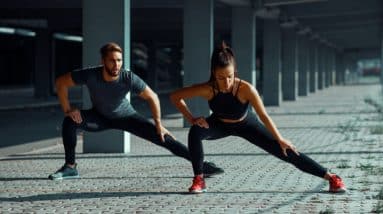
10 Leg Stretches That Will Supercharge Your Lower Body Fitness
If you do it right, leg day is an intense experience. Squatting, lunging, and hinging until you’re a puddle on the gym floor takes up a lot of time and mental real estate. But once you’ve crushed your leg exercises, you’ve got to reassemble yourself — leg stretches can do that very well.
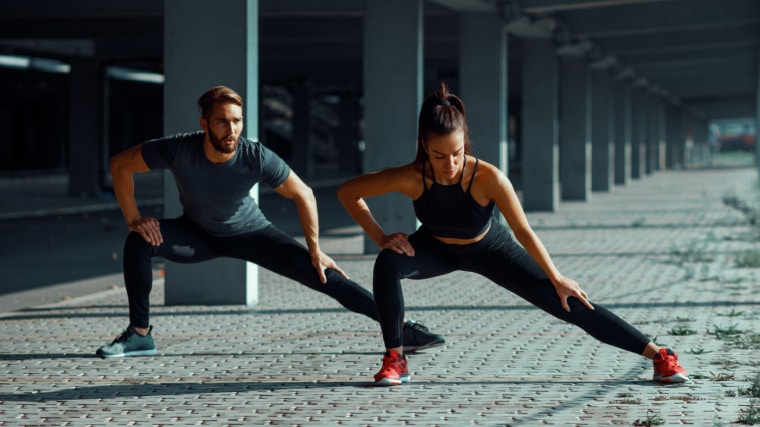 Credit: djile / Shutterstock
Credit: djile / Shutterstock
Leg day is not just about strength. It’s also one way to stay on top of your mobility, using loaded stretching as a tool to double down on your flexibility. Leg stretches are a massive asset in preparing for a bodyweight leg workout or helping you cool down after the fact. If you’re looking to flex some lower limb knowledge, here are the 10 best leg stretches.
Best Leg Stretches
- Seated Pigeon Pose
- Pigeon Pose
- Half-Kneeling Hip Flexor Stretch
- Couch Stretch
- Adductor Split Stance Stretch
- Frog Pose
- Hurdler’s Stretch
- Standing Toe Touch
- World’s Greatest Stretch
- Calf Stretch
Editor’s Note: The content on BarBend is meant to be informative in nature, but it should not be taken as medical advice. When starting a new training regimen and/or diet, it is always a good idea to consult with a trusted medical professional. We are not a medical resource. The opinions and articles on this site are not intended for use as diagnosis, prevention, and/or treatment of health problems. They are not substitutes for consulting a qualified medical professional.
1. Seated Pigeon Pose
[Read More: Yoga for Bodybuilding: How Getting Flexible Helps You Gain Muscle]
Primarily targeting the glutes, the pigeon pose delivers a very efficient stretch with scalable options for all mobility levels. But the classic, original variation can be tricky to learn.
Enter the seated pigeon pose. This variation allows you to choose the position that best serves your current needs. Use this option to ease into leg stretches and practice pristinely controlled stretching.
How to Do it:
- Sit on the edge of a weight bench with your feet flat on the floor. Aim for your legs to make an approximate 90-degree angle at the knee.
- Place your left ankle on top of your right knee, creating a figure-four position with your legs.
- Keep a tall posture and lightly hinge forward until you feel a stretch across your glutes.
Coach’s Tip: Be sure to maintain square hip and knee positioning. Try not to let your support knee drift off to one side as this diminishes the stretch.
Sets and Reps: Perform 2-4 sets of a 30-second timed hold on each side. No rest is required between sets.
2. Pigeon Pose
[Read More: How Strength Athletes Can Add Yoga to Their Program]
The classic pigeon pose is the next step in stretching your glutes. Where the seated pigeon pose uses a bench as a support, the classic pigeon pose places you on the floor. This small change increases the mobility demands but also allows for a potentially deeper stretch.
How to Do it:
- Place one leg on the floor with your shin and foot resting underneath your body.
- The opposite leg should be flat on the floor behind the rest of your body.
- Keep your back straight and slightly lean forward, similar to performing a hinge.
- Choose a shin angle on your forward leg that allows you to feel a deep stretch in your glute but isn’t forced into position. Hold for time.
Coach’s Tip: You don’t need to aim for a completely straight left-to-right shin angle for benefits here. Find the shin angle that allows you to feel a mild stretch without discomfort.
Sets and Reps: Hold the pigeon pose for 2-4 sets of 30 seconds. Perform a 30-second stretch on both sides to complete one set.
3. Half-Kneeling Hip Flexor Stretch
[Read More: New Study Finds That Stretching Can Directly Create Muscle Growth]
Between training the lower body and the amount of sitting involved in the average lifestyle outside of the gym, your hip flexors are almost certainly tight at some stage of the week.
The hip flexors are a group of muscles that sit at the top of your thigh around your hip crease. While it doesn’t take a hard sell to get most people stretching them (it feels really good), nailing the technique is paramount for the best results.
How to Do it:
- Kneel down on your right knee, making a 90-degree angle on your left leg.
- Keep your hips square and pointed straight ahead.
- Brace your core and prevent any flaring of your ribcage.
- Squeeze your glute on your right leg, pushing your hips forward naturally. Hold this posture by maintaining the glute squeeze.
Coach’s Tip: Keep your torso stacked over your hips on this stretch. Squeezing the glute extends your hip and gives you all the stretch you need in the perfect spot.
Sets and Reps: Perform 2-4 sets of 30 seconds per leg, alternating sides without resting until all sets are complete.
4. Couch Stretch
[Read More: How to Do the 90/90 Stretch to Squat Heavier and Move Better]
The couch stretch is an advanced version of the half-kneeling hip flexor stretch. Whether you’re using a bench, yoga block, or couch itself, this is a move you should ease into. A deeper stretch or higher pain tolerance isn’t necessarily the name of the game for stretching your legs. Dial in the right spot and you’ll get everything you need from the couch stretch.
How to Do it:
- Kneel down on your right leg with a couch (or bench) placed close behind you.
- Make a 90-degree angle with your left leg ahead of you.
- Place your right ankle or the top of your right foot on the edge of the coach (or bench).
- Flex your right glute and keep your back straight as you feel a stretch develop across the length of your right quadriceps.
Coach’s Tip: Be sure to maintain a stacked torso posture here as well. Do not arch your back or you may begin losing the stretch in the place you’re trying to target.
Sets and Reps: Perform 2-4 sets of 30 seconds per leg here, starting slow and easing into it. There is no need for rest between legs. You can simply alternate once each hold is complete.
5. Adductor Split Stance Stretch
[Read More: 7 Stretches That Can Help Your Posture]
The adductors are the inner thighs and are often forgotten about when the time comes to stretch the legs. Your quads, glutes, and hamstrings (and even calves!) are usually pretty obvious targets, but your adductors are very important as well.
Something as simple as an adductor split stance stretch is enough to make a difference in your lower leg mobility. Making sure the adductors are properly stretched before or after your workouts may help improve the range of motion on many movement patterns.
How to Do it:
- Take a standing position with your legs set outside of shoulder width.
- Keep your feet pointed straight ahead or subtly pointed out.
- Brace your core and shift your weight more towards your left leg.
- Keep your right leg straight and bend the left knee. Slowly push your right leg towards the floor.
Coach’s Tip: Ease into the adductor split stance stretch. The adductors are often targeted less and hold a lot of tension, so you won’t need much to start feeling them.
Sets and Reps: Perform 2-4 sets of 30-second timed holds per side, switch sides without resting to complete all sets.
6. Frog Pose
[Read More: How Deep Stretching Promotes Emotional Release]
You’ll be working on dynamic stretching here. This stretch, borrowed from yoga, is a floor variation of the split stance adductor stretch and thus also stretches your inner thighs.
The frog pose is scalable and more dynamic than the split stance adductor stretch, allowing you to rock back and forth to find the perfect position. The frog pose is also extremely time-efficient as you won’t need to switch sides. One well-executed frog pose stretches both adductors at the same time.
How to Do it:
- Kneel down on your exercise mat and assume a quadruped position (on your hands and knees).
- Widen your leg stance enough that you create a triangle with your legs and the floor. You should place your weight onto the inner portion of your knees.
- Widen the leg stance as much as needed to begin feeling an adductor stretch.
- Using your arms, move yourself forward and backward to find the appropriate stretch across your adductors.
Coach’s Tip: Ease into your frog pose. The adductors are often tight and the frog pose is a very effective position to stretch them. It won’t take much to get started.
Sets and Reps: Hold your frog pose for 2 sets of 30 seconds to 1 minute at a time. You won’t need to switch sides as one frog pose stretches both adductors simultaneously.
7. Hurdler’s Stretch
[Read More: The 9 Best Stretches for CrossFit Athletes to Maximize Performance]
You might remember this one from middle school. The hurdler’s stretch is a simple way to begin stretching out your hamstrings and adductors but allows you to individually target each side. Using your own body as a landmarking tool for progress, reach for your toes and see how quickly your mobility improves each session.
How to Do it:
- Take a seat on the floor, extend your right leg slightly off to one side, and bring your left foot into your right inner thigh.
- Flex your right ankle to the sky to start your stretch, keeping your left foot in contact with your right thigh.
- Keep your back straight as you subtly begin to lean towards your right foot.
- Reach for your right foot and ease into a slight hamstring and adductor stretch.
Coach’s Tip: Once you have mastered the standard hurdler’s hamstring stretch, try rounding your back to move through other commonly stiff areas (for example, the lower back).
Sets and Reps: Perform 2-4 sets of 30 seconds per side. Alternate stretches between legs without resting.
8. Standing Toe Touch
[Read More: Active Stretches Explained — Science-Backed Selections for Optimal Recovery & Performance]
While simply bending over is usually enough to start feeling the stretch, adding a bit of finesse to your technique is a quick way to alter what you’re targeting. Shifting from side to side, or even keeping your back straight or rounded are ways to change the focal point of the standing toe-touch.
How to Do it:
- Take a close foot stance (about hip-width or closer) with your toes pointed straight ahead.
- Bend over and reach for your toes, allowing your back to round and relax into a deep stretch.
- You can also bring one foot into your hand and kick your foot back into your hand — this will provide a good quad stretch.
Coach’s Tip: Initiate with more of a hinge technique for a better hamstrings and glute stretch, or shift to one side for a better stretch into your quadratus lumborum.
Sets and Reps: Perform 2 sets of 30 seconds to 1-minute of the standing toe-touch. If you are emphasizing one side or using a different technique, perform the stretch once on both sides to complete one set.
9. World’s Greatest Stretch
[Read More: 7 At-Work Stretches to Boost Your Gym Performance]
The world’s greatest stretch is named as such because it hits your adductors, hip flexors, glutes, and thoracic spine all at the same time. While it is taxing in its own right with all the moving parts, it would be hard to find a more well-balanced stretch for your routine.
How to Do it:
- Get into a deep lunge, sending your right leg ahead of your body and sinking into your right hip.
- In this extended lunge position, keep your hips square while you rotate your thoracic spine to face the floor before turning your torso to face the right.
- Switch legs and perform for repetitions, holding each part of the stretch for a few seconds at a time to stretch each muscle.
- Perform even repetitions on your left side and your right.
Coach’s Tip: Start small and work up. The world’s greatest stretch may feel like a workout itself, perform a handful of repetitions per side and rest as needed.
Sets and Reps: Perform 2-5 repetitions of the world’s greatest stretch per side. Hold each stretch sensation for 5-10 seconds before alternating sides. Rest between sides as necessary.
10. Calf Stretch
[Read More: Try These 8 Tight Calves Stretches to Improve Ankle Mobility]
Don’t neglect your calf muscles. But where many leg stretches take some effort to get into and hold, the calf stretch is a nice way to truly relax as you cool down. Performed either against a wall or with a small wedge, this one takes minimal effort for its benefits.
How to Do it:
- Take a front-to-back split stance with your lead foot placed upon a wedge.
- Flex your front ankle up to start the standing calf stretch. Keep your back leg flat or on the ball of your foot to support.
- Keep your knee on the lead leg slightly bent to prevent hyperextension.
- Lean forward into the lead leg, keeping the ankle flexed up and stretching your calf.
Coach’s Tip: Keep your back straight and perform a hinge technique to get the best stretch in your calf without spilling over into other muscles.
Sets and Reps: Perform 2-4 sets of 30 seconds per leg. There is no need to rest between sets, simply perform all rounds back to back.
Warming Up for Leg Stretches
As much as possible, avoid stretching your muscles cold. You don’t want to sink too deeply into a stretch suddenly before your muscles are acclimatized. Think of it like performing ramp-up sets of back squats — you do some reps with an empty barbell and then gradually get heavier instead of diving right into your working sets.
Something as simple as five to 10 minutes of moderate cardio can improve your stretch session with minimal upfront effort.
A few examples may include:
- Stair Climber: 5 minutes at moderate intensity.
- Exercise Bike: 10 minutes at moderate intensity.
- Elliptical: 10 minutes at moderate intensity.
- Rowing Machine: 5 minutes at moderate intensity.
How to Train for Leg Flexibility
Using both dynamic and static stretching can help enhance your lower body flexibility. Incorporating stretches before or after your leg day during a structured dynamic warm-up or cool-down is the obvious route, but the resistance training session flow itself works well too.
Try performing your lower body exercises (for example Romanian deadlifts or Bulgarian split squats) with tempo training techniques.
Controlling the eccentric portion (the lowering half) of each repetition is a way to incorporate loaded stretches into your routine. In combination with your warm-up or cool-down routine, loaded stretches are a powerful way to build and maintain your flexibility.
Selecting Leg Stretches
Your program helps direct which stretches you’ll get the biggest benefit from. Warming up is a great way to identify where you feel tightness and best select the stretches for you. Once you have completed your general cardio warm-up, make sure to take on some lower-load ramp-up sets for your first exercise.
Visual feedback on your technique (from the mirror, film, or a trusted training buddy or certified personal trainer (CPT) can help you figure out what areas you need to work on. You can also simply monitor where you’re feeling tight to..
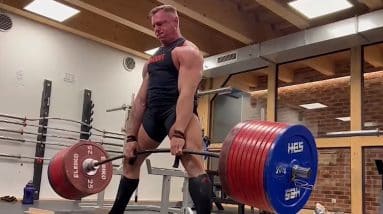
Krzysztof Wierzbicki Astonishes with Jaw-Dropping 510-Kilogram Beltless Deadlift Off Blocks
Polish powerlifter Krzysztof Wierzbicki is deadlifting unfathomably heavy again. The 110-kilogram lifter shared a video on his Instagram page on Jan. 17, 2024, wherein he pulled a monstrously heavy 510 kilograms (1,124.4 pounds) off blocks in a sumo stance while wearing lifting straps.
While Wierzbicki’s deadlift was not pulled off the floor — meaning that the range of motion from the bottom of the lift to lockout is narrowed — he did not wear a lifting belt. You read that right: Wierzbicki locked out a 510-kilogram deadlift off blocks without any equipment other than lifting straps. Check it out below:
View this post on InstagramA post shared by Krzysztof Wierzbicki (@mr.deadlift)
[Related: Brian Le (66KG) Raw Deadlifts 12.5 Kilograms Over the IPF World Record In Training]
Given that Wierzbicki has pulled the heaviest deadlift ever seen on camera — a 502.5-kilogram (1,107.8-pound) sumo pull in April 2022 — it should not come as a surprise that he is continuing to add weight to the barbell.
However, adding 7.5 kilograms (16.5 pounds) in the context of the heaviest-ever-seen deadlift is surprising. To contextualize, it can’t be contextualized. That range was unfathomable, as it was uncharted territory since no human had ever done it. Wierzbicki just almost (read: off blocks) did it.
For reference, below is the video of that 502-kilogram effort:
View this post on InstagramA post shared by Julian Howard (World’s Strongest Fan) (@worldsstrongestfan)
[Related: Amanda Lawrence (84KG) Squats a 250.5-Kilogram Raw Double]
Wierzbicki did not share his body weight at the time of this remarkable 510-kilogram block-pull. He does, however, appear more muscular than his previous deadlift PR, though camera angles can be deceiving. The 510-kilogram block pull was 4.64 times his 110-kilogram competition body weight.
The closest comparison to this pull is less likely to be found in competitive powerlifting and more likely to be found in the world of competitive strongman. The partial deadlifts performed in strongman are at similar weights; the current Hummer tire deadlift is 549 kilograms (1,210 pounds), locked out by 2020 World’s Strongest Man Oleksii Novikov of Ukraine at the 2022 Shaw Classic.
However, the similarities of Novikov’s record lift more or less end at the weight. Novikov pulled in an equipped conventional stance rather than a nearly raw (straps) sumo stance, and rather than weight plates on the barbell, there were giant treaded wheels intended for a gas-guzzling SUV.
Rauno Heinla holds the all-time 18-inch deadlift world record at 540 kilograms (1,190.5 pounds), scored at the 2023 Tartu Rammumees ja Rammunaine contest in Tartu, Estonia. Similar to Novikov’s lift, Heinla’s was performed in a conventional stance, though only with lifting straps and a weight belt, but with weight plates the size of Vauvillian bicycle wheels.
View this post on Instagram
A post shared by Rauno Heinla (@rauno_heinla)
Wierzbicki is more or less in a league of his own, forging a path into the realm of what is humanly possible with a barbell off the ground. Onlookers can assume Wierzbicki either has the capacity to add more weight to the barbell, eventually remove the blocks, or both.
Featured image: @mr.deadlift on Instagram
The post Krzysztof Wierzbicki Deadlifts 510 Kilograms Beltless Off Blocks In Training appeared first on BarBend.

Results of Team Event 5 at the 2024 Wodapalooza Miami
The penultimate event of the 2024 TYR Wodapalooza Miami competition featured a three-round waterfall-style exercise trio of biking, box step-overs, and kettlebell hang snatches.
Team Ice Barrel — Brooke Wells, Baylee Rayl, and Paige Powers — posted the top time among the female teams to build momentum with only one workout to go. Team TYR — Ricky Garard, Jayson Hopper, and Dallin Pepper — sealed the deal for the male teams.
[Stay Tuned: 2024 Wodapalooza Miami Live Results and Leaderboard]
View this post on InstagramA post shared by Baylee Rayl Christophel (@bayleerayl)
Elite Team 5 Results — Waterfall on the Bay
For time, each athlete completes three rounds (waterfall style) of:
- Echo Bike — Men: 24 calories | Women: 18 calories
- Eight Kettlebell Box Step-Overs — Men: 53 pounds | Women: 35 pounds
- 12 Double Kettlebell Hang Snatches
[Related: 2024 Wodapalooza Miami Team Event 4 Results]
Elite Female Team Results
- Team Ice Barrel — 10:24.94
- Stronger Than a 90s Trend — 10:54.69
- Rx Performance — 10:57.00
- Team Bareen — 11:06.65
- NGH — 11:17.34
- Team Scandinadian — 11:18.87
- Fearless Misfits — 11:19.83
- Team Treta — 11:38.75
- Mile High Muscles — 11:46.91
- Kolesnikov Team — 11:49.04
- Dixieland Delight — 11:49.21
- Team Frog Grips — 11:56.81
- Three Queens — 12:00.52
- Lycan Gang — 12:17.03
- Plus Ultra — 12:18.69
- Lifters Girls — 12:19.51
- Reebok Crew — 12:20.70
- US Army Warrior Fitness — 12:21.09
- Conquer Cuties — 12:34.50
- Base Wellness — 12:44.59
- Trailer Park Girls — 13:11.25
- Kriger Meets Trainingculture — 13:13.09
- Torian Black — 13:19.15
- Firebarns Club — 13:24.32
- Leapin Lemurs — 13:30.65
- Limey Girls — 13:34.79
- Sweet Sticky Thicc and Pretty — 13:50.02
Elite Male Team Results
- Team TYR — 9:20.00
- Team Picsil — 9:48.94
- The Strapping Young Lads — 9:55.89
- Team GOWOD — 10:02.89
- Ombré Hombres — 10:26.33
- Picsil Traincult — 10:41.52
- Team Gorila 911 — 10:44.47
- Complex Wodex — 10:47.60
- Conquer Athlete — 10:49.22
- Tres Leches — 10:51.50
- Project Girona — 10:54.21
- CrossFit Mayhem the Empire — 11:05.39
- Omnia — 11:13.77
- Truecoach Traincult — 11:19.87
- EFP — 11:25.53
- Canadians From the East — 11:29.16
- Foxed Ferret Manatee Men — 11:32.60
- Krypton — 11:38.90
- Velitus Traincult — 11:43.43
- Kinesis Black — 11:43.66
- Maxlift Australia — 11:51.44
- Team Overtake — 12:19.51
- Midwest Cowboys — 12:41.00
- Soul Ab Squad — 12:42.66
- DSM Performance TCC — 13:10.59
- Team Evolve — 13:11.63
- Tenskills Pro 1 — 13:21.84
- Rehab to Perform — 13:50.26
- Mayhem Outlaws DNF
- Rx Smart Gear WD
The last event for the Teams division at the 2024 TYR Wodapalooza is titled “Worm Fran,” and it is exactly what it sounds like — thrusters, pull-ups, and muscle-ups galore.
Featured image: @bayleerayl on Instagram
The post 2024 Wodapalooza Miami Team Event 5 Results appeared first on BarBend.
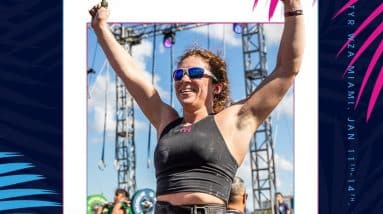
Results of Individual Event 3 at the 2024 Wodapalooza Miami Competition
The closing event of Day One at the 2024 TYR Wodapalooza Miami contest was titled “Deja Vu.” The adjusted workout at Bayfront Park in Miami, FL, due to inclement weather, challenged athletes to row, throw wall balls, pull their chins to the bars, jump over boxes, and snatch some dumbbells.
Below are the full results:
[Stay Tuned: 2024 Wodapalooza Miami Live Results and Leaderboard]
Event 3 Results — Deja Vu
Part A: Three minutes. Part B: Five minutes. Part C: For time (eight-minute time cap). One minute rest between each part.
- Assault Row — Men: 25 calories | Women: 20 calories
- 30 Wall Balls — Men: 20 pounds | Women: 14 pounds
- Strict Chin-Over-Bar Pull-Ups — Men: 20 reps | Women: 14 reps
- 30 Box Jump Overs — Men: 24-inch box | Women: 20-inch box
- 25 Single-Arm Dumbbell Snatches — Men: 100 pounds | Women: 70 pounds
This workout will apply two scores:
- Total reps across all parts
- Time on Part C
View this post on InstagramA post shared by The TYR Wodapalooza (@wodapalooza)
[Related: 2024 Wodapalooza Miami Individual Event 2 Results]
Results are recorded as follows: Athlete (number of reps + time)
Elite Individual Women’s Results
Emma Cary made a big push for the top spot during the last two events of the day. And with only a two-day, five-event weekend, a big push did the trick. The three-time CrossFit Games athlete took first place overall in this event, edging out Arielle Loewen. She came in second to Loewen’s first in Event 2, and successfully switched the order around in Event 3.
In doing so, she tied up second place on the leaderboard, just six points behind overall leader Gabriela Migala.
- Emma Cary (182 + 05:31.0)
- Arielle Loewen (180 + 06:36.4)
- Rebecka Vitesson (170 + 06:15.4)
- Gabriela Migała (169 + 06:18.0)
- Danielle Brandon (166 + 05:56.2)
- Abigail Domit (166 + 06:02.2)
- Rebecca Fuselier (166 + 06:44.6)
- Elizabeth Wishart (165 + 06:53.8)
- Lexi Neely (165 + 06:54.8)
- Sydney Wells (160 + 06:18.2)
- Emily Rolfe (160 + 06:19.9)
- Keara Napoli (157 + 06:52.4)
- Katie Canning (157 + 07:21.4)
- Nina Vragovic (157 + 07:24.4)
- Gabrielle Spenst (156 + 07:21.4)
- Caroline Stanley (155 + 06:36.3)
- Olivia Kerstetter (153 + 06:51.1)
- Jessica Androsik (151 + 07:01.9)
- Callista Lang (150 + 07:02.1)
- Margaux Masset (149 + 07:06.9)
- Grace Walton (147 + 06:20.6)
- Emily De Rooy (147 + 07:44.5)
- Ro Scott (147 + 07:58.7)
- Briony Challis (146 + 07:04.0)
- Andra Moistus (144 + 06:10.1)
- Becca Merritt (143 + 07:17.5)
- Feeroozeh Saghafi (142 + 06:04.7)
- Elena Carratala Sanahuja (142 + 07:07.6)
- Emily Rethwill (142 + 07:15.9)
- Freya Moosbrugger (141 + 06:28.1)
- Allison Weiss (141 + 06:54.5)
- Stacy Lerum (140 + 06:55.7)
- Bergros Bjornsdottir (140 + CAP + 109)
- Dani Speegle (135 + 06:37.5)
- Nicolette Torreggiani (135 + 06:46.0)
- Christee Hollard (135 + 07:07.3)
- Julia Hannaford (135 + 07:50.5)
- Ellia Miller (131 + CAP + 108)
- Ashley Shoemaker (124 + CAP + 117)
- Matilde Oyen Garnes WD
Elite Individual Men’s Results
The men’s side of the competition was full of climbing in Event 3, too. Ricky Garard, who had started the weekend with a lackluster 13th-place finish, also started his climb in Event 2 with a third-place run.
In Event 3, all bets were off as Garard worked his way to first place in the event and on the overall leaderboard. He’ll start off the second and final day of competition just 4.5 points ahead of Patrick Vellner for the top podium spot.
- Ricky Garard (199 + 06:02.1)
- CJ Gerald (198 + 06:44.6)
- Samuel Kwant (195 + 05:53.1)
- Brent Fikowski (193 + 07:48.0)
- Patrick Vellner (190 + 06:04.0)
- Jacob Heart (190 + 06:12.5)
- Roman Khrennikov (189 + 06:29.4)
- Samuel Cournoyer (186 + 06:12.6)
- Jack Farlow (184 + 05:59.0)
- James Sprague (184 + 06:08.9)
- Colten Mertens (184 + 06:43.1)
- John Wood (184 + 06:54.4)
- Nick Mathew (183 + 07:24.2)
- Austin Hatfield (181 + 06:11.6)
- Evan Rogers (181 + 06:54.1)
- Lucas Heuze (180 + 06:39.8)
- Travon Benton (179 + 06:38.8)
- Jack Rozema (179 + 07:06.0)
- Alex Vigneault (179 + 07:15.4)
- Connor Voltz (178 + 06:40.2)
- Harry Lightfoot (178 + 06:41.4)
- Henrik Haapalainen (178 + 07:08.0)
- Drake Lewis (177 + 04:42.3)
- Bronislaw Olenkowicz (176 + 06:50.5)
- Antonios Makaronas (175 + 07:42.1)
- Kalyan Ribeiro De Souza (174 + CAP + 122)
- Guilherme Malheiros (173 + 06:54.4)
- Luke Parker (173 + 07:07.3)
- Kaique Cerveny (172 + 07:08.7)
- Joshua Hong (170 + 07:40.6)
- Spencer Panchik (169 + 05:49.7)
- William Bennett (169 + 07:08.5)
- Francis Pelletier (168 + 07:24.0)
- Juan Ignacio Sforzini (163 + 07:15.9)
- Guilherme Domingues (160 07:51.1)
- Tanner Balazs (153 + CAP + 111)
- Arturo Torres (147 + CAP + 114)
- Nikita Yundov (141 + 07:55.3)
- Martin Feiferlik (129 + CAP + 115)
- Kevin Jurs DNF
- Alexandre Caron WD
[Related: 2024 Wodapalooza Miami Individual Event 1 Results]
The second day of competition for Individuals will feature the remaining two workouts. Once Individual champions are crowned, the Elite Teams will take the competition floor on Jan 13-14 for their competition in Miami.
Featured image: @
The post 2024 Wodapalooza Miami Individual Event 3 Results appeared first on BarBend.






